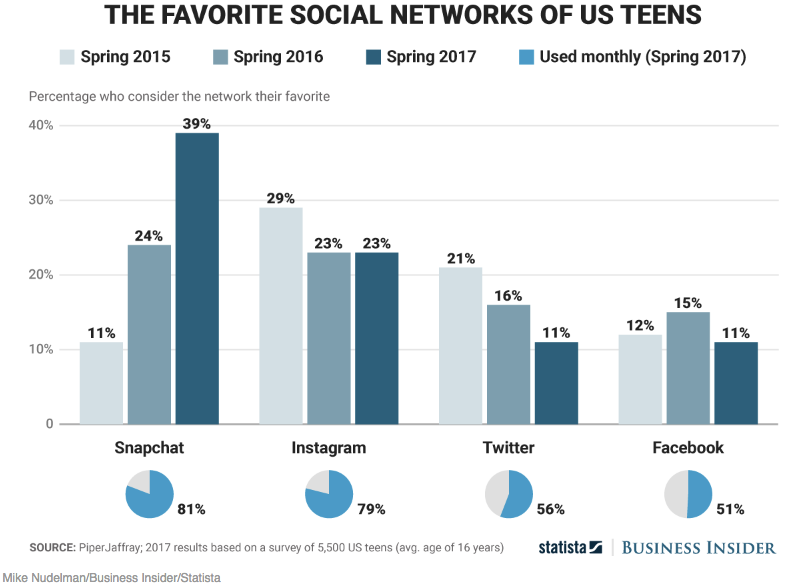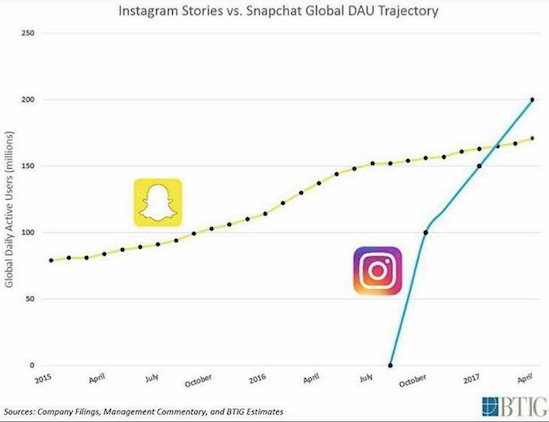This comes only 6 months after the launch of the Instagram stories feature indicating that consumers prefer a consolidated social media model. With the integration of Instagram comment accessibility on Facebook Business pages, Snapchat continues to be left behind. It does not matter what filter you throw on the situation, the reality is that Snapchat’s reign may be coming to an end. What about the young folk?Snapchat has become increasingly popular since its founding in 2011 and they still dominate the teen market, at least in preference. A study recently conducted by Piper Jaffray, a leading investment and asset management firm, found that 39% of teens prefer Snapchat. Only 23% favored Instagram.
While this model appears to tout Snapchat’s popularity, it illustrates the problem with its model. They walk a fine line, attempting to make its platform young and hip while not alienating older users. This is where Snapchat falls into a paradox. The app’s popularity with teens is due in large part to the fact that there is not an older demographic who use it like they do.
By having a space specifically carved out for younger people, Snapchat creates an immensely popular app for those with spare time and a wide array of peers that they interact with daily. However, its complicated interface, lack of historical content, and market concerns over privacy keep it from reaching a wider demographic. This exclusivity is appealing to teens, making its biggest strength, its ultimate liability. Learning From Twitter When Twitter went public on November 7th, 2013 expectations were high. The social media app started at $26 per share and ended the day at $44 per share. The market was confident in the 140-character-or-less platform. Right now its stock price hovers at around $14. According to Twitter’s own statistics, it boasts about 313 million monthly active users. Even though its business model leaves uncertainty with shareholders, it is still an immensely popular platform with frequent engagement. Twitter remains entrenched in our culture and even more so now that it is our 45th president’s platform of choice. That being said, the company has not had a profitable quarter since it went public 4 years ago. A big part of this trend is growth. The 313 million monthly users figure has been virtually unchanged in the last year. Their stagnation has allowed for other apps such as Instagram and Snapchat to surge past them. Part of this has to do with tumultuous leadership; Twitter has gone through six heads of product in the last six years. CEO Jack Dorsey was pushed out in 2008, only to return to the company last year. This lack of stability has hindered growth and innovation, making the company’s direction aimless. While Twitter remains intensely popular with its users, it has done nothing to broaden its appeal, and for a tech company that spells disaster. Another problem Twitter faces, and one that I personally see arising with Snapchat, is their trouble with advertisements. While Twitter maintains big brand advertisers, they have not been as successful as Facebook at integrating direct marketing into their platform. This is a potential problem for Snapchat. While companies are able to create creative content on the app that both entertains and informs users, Snapchat also allows for consumers to skip over ads with the touch of a button. The ability to flush away any unwanted content at the touch of a button, devalues the advertisement as a whole. Interestingly though, the Discover section of Snapchat has provided advertisers with an opportunity to create captivating content that consumers seek out. This has been a boon for big money advertisers (like ESPN, Buzzfeed, etc.), but leaves out the little guy who cannot create engaging content at the pace of these big brands. This trade off may end up hurting Snapchat in the long run, much like what happened to Twitter. Copy Cat Every move Snapchat makes, Instagram copies.They also are able to do it better thanks to the big money backing Facebook provides. They are also getting faster at the process. It took Instagram almost 3 years to copy the story feature. It took them a little less than 2 years for location filters. AR Stickers? 1 year. Create your-own stickers? 4 months. And since Instagram went live with Stories, Snapchat’s growth has shrunk by 82%.
Experts agree, slow growth means that Wall St. may panic and the market could bail on the company. Monness, Crespi, Hardt analyst James Cakmak, claimed to CNN, “Since they’ve managed to successfully change the way advertisers think, investors should be an easier sell,” He then added a caveat: “So long as the growth curve remains steep.”
This has not been the case. Snapchat opened at $26.39 per share on March 3rd, and closed this past Friday a hair above $20. On May 10th the company will announce its quarterly earnings and will most reported losses rumored to be just shy of $200 million. Instagram’s shameless cloning of Snapchat’s features has negated the innovation stemming from this platform. Even though Snapchat’s creating much better content, Instagram’s ability to copy and implement seamlessly to its already massive user base is overwhelming Snapchat’s ability to grow. People will continue to stay on Instagram as long as they consistently match Snapchat’s features. This mirrors Twitter’s situation. When Twitter focused on live events and streaming via Periscope, Facebook sunk a lot of cash into its Live feature. Twitter just could not respond to the influx of money Facebook was able to spend, and the way that Facebook has integrated live streaming into its platform is much more effective than Twitter’s. Live video is incredibly valuable to Facebook’s algorithm and users are consistently prompted to engage with the feature. Even though Twitter had the headstart, its in-app live streaming service only became available in December of 2016, a full year after Facebook had created the feature on its platform. What Does the Future Hold?I talked to entrepreneur and CEO of FilterHaus, the world’s first custom geofilter agency, Austin Dixon, about this issue. I asked him what he thought about Snapchat’s future viability and whether or not the app could survive. He opined, “With where the app stands today, absolutely not. The power and scale that Facebook & Instagram have will continue to diminish Snapchat’s user base.” When I questioned him about the mimicking tactics of Instagram, he surprised me with his candid response: “I think Instagram is smart for copying Snapchat. I think they did a really great job at looking at Snapchat’s product and finding pain points with it. Most importantly, Instagram released IG Stories at the perfect time after Snapchat took away the auto-advance feature for users stories. Because of this, many content creators saw a huge drop (anywhere from 30% to 60%) in views. So, it made more sense to jump on IG Stories because that’s where the eyeballs already are.” As for becoming like Twitter, Dixon believes that it is Snapchat’s management at the top differentiating the two: “One thing I think the company has behind them is a strong executive team. Aside from the cofounders, Imran Kahn (Chief Strategy Officer) has a tenured background that I think really aligns well with the company’s goals.” With this being a reality, Snapchat needs to adapt. They simply don’t have the resources to outmaneuver Facebook. Even though they continue to push forward with innovative ideas, they simply cannot go point for point with Facebook, and Dixon agrees: “In my opinion, Facebook is too big, has too much money, and will continue to parallel Snapchat features that catch on with consumers. Because of this, Snapchat will need to either rapidly innovate OR find a way to become less of a competitor of Facebook (sidenote: the latter is super hard to do at this point).” He also has an idea how: “I believe Snapchat could become a form of mobile television. We’ve already seen that short form content (think of Snapchat Feature Stories) can perform well on the app. If Snapchat can find a way to become less peer-to-peer and more Business to Client, I could see channels developing on the app that users subscribe too. Behaviorally, the millennial demographic already uses Snapchat as the “TV in between traditional TV”, so I really think if Snapchat finds a way to empower more content creators and publishers to create channels we could see a shift in how the app is used.” As for where Snapchat goes from here: “However, it’s going to come down to numbers (because that’s how tech and advertising work). If Snapchat can’t grow it’s user base, we’re going to have to say goodbye to the biggest tech busts of our lifetime.” After the first quarterly earnings report as a public company, with Snap Inc. losing $2.2 billion, one thing is clear, a year from now Snapchat will either look drastically different than it does today, or it will be that much closer to disappearing like their trademark messages. Author Bio Henry Burgess-Marshall is the Co-Founder & Head of Marketing at Maribel Creative Agency, a digital design firm based out of Seattle, WA. You can follow him on Twitter: @henryinseattle and Instagram: @henryburgessmarshall |
Categories
All
Archives
November 2023
|
|
Locations:
New Orleans, LA Nashville, TN |
|
Digital Media Ghost @2020
|




 RSS Feed
RSS Feed
